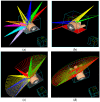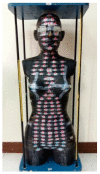Dosimetric Comparison of Intensity-Modulated Radiotherapy, Volumetric Modulated Arc Therapy and Hybrid Three-Dimensional Conformal Radiotherapy/Intensity-Modulated Radiotherapy Techniques for Right Breast Cancer
- PMID: 33260404
- PMCID: PMC7760558
- DOI: 10.3390/jcm9123884
Dosimetric Comparison of Intensity-Modulated Radiotherapy, Volumetric Modulated Arc Therapy and Hybrid Three-Dimensional Conformal Radiotherapy/Intensity-Modulated Radiotherapy Techniques for Right Breast Cancer
Abstract
This study aimed to compare different types of right breast cancer radiotherapy planning techniques and to estimate the whole-body effective doses and the critical organ absorbed doses. The three planning techniques are intensity-modulated radiotherapy (IMRT), volumetric modulated arc therapy (VMAT; two methods) and hybrid 3D-CRT/IMRT (three-dimensional conformal radiotherapy/intensity-modulated radiotherapy). The VMAT technique includes two methods to deliver a dose: non-continuous partial arc and continuous partial arc. A thermoluminescent dosimeter (TLD) is placed in the RANDO phantom to estimate the organ absorbed dose. Each planning technique applies 50.4 Gy prescription dose and treats critical organs, including the lung and heart. Dose-volume histogram was used to show the planning target volume (V95%), homogeneity index (HI), conformity index (CI), and other optimized indices. The estimation of whole-body effective dose was based on the International Commission on Radiation Protection (ICRP) Publication 60 and 103. The results were as follows: Continuous partial arc and non-continuous partial arc showed the best CI and HI. The heart absorbed doses in the continuous partial arc and hybrid 3D-CRT/IMRT were 0.07 ± 0.01% and 0% (V5% and V10%, respectively). The mean dose of the heart was lowest in hybrid 3D-CRT/IMRT (1.47 Gy ± 0.02). The dose in the left contralateral lung (V5%) was lowest in continuous partial arc (0%). The right ipsilateral lung average dose and V20% are lowest in continuous partial arc. Hybrid 3D-CRT/IMRT has the lowest mean dose to contralateral breast (organs at risk). The whole-body effective doses for ICRP-60 and ICRP-103 were highest in continuous partial arc (2.01 Sv ± 0.23 and 2.89 Sv ± 0.15, respectively). In conclusion, the use of VMAT with continuous arc has a lower risk of radiation pneumonia, while hybrid 3D-CRT/IMRT attain lower secondary malignancy risk and cardiovascular complications.
Keywords: hybrid 3D-CRT/IMRT; intensity-modulated radiotherapy; right breast cancer; volumetric modulated arc therapy.
Conflict of interest statement
The authors declare no conflict of interest. The funders had no role in the design of the study; in the collection, analyses, or interpretation of data; in the writing of the manuscript, or in the decision to publish the results.
Figures






Similar articles
-
A dosimetric comparison of double-arc volumetric arc therapy, step-shoot intensity modulated radiotherapy and 3D-CRT for left-sided breast cancer radiotherapy after breast-conserving surgery.Technol Health Care. 2017 Oct 23;25(5):851-858. doi: 10.3233/THC-160746. Technol Health Care. 2017. PMID: 29103057
-
Dosimetric Study Comparing 3D Conformal Radiotherapy (3D-CRT), Intensity Modulated Radiotherapy (IMRT) and Volumetric Modulated Arc Therapy (VMAT) in Hypofractionated One-Week Radiotherapy Regimen in Breast Cancer.Cureus. 2022 Nov 24;14(11):e31860. doi: 10.7759/cureus.31860. eCollection 2022 Nov. Cureus. 2022. PMID: 36440297 Free PMC article.
-
Hybrid planning techniques for early-stage left-sided breast cancer: dose distribution analysis and estimation of projected secondary cancer-relative risk.Acta Oncol. 2023 Aug;62(8):932-941. doi: 10.1080/0284186X.2023.2238553. Epub 2023 Jul 30. Acta Oncol. 2023. PMID: 37516978
-
Hybrid Treatment Planning for Chest Wall Irradiation Utilizing Three-Dimensional Conformal Radiotherapy (3DCRT), Intensity-Modulated Radiation Therapy (IMRT), and Volumetric Modulated Arc Therapy (VMAT): A Systematic Review.Cureus. 2024 May 3;16(5):e59583. doi: 10.7759/cureus.59583. eCollection 2024 May. Cureus. 2024. PMID: 38832195 Free PMC article. Review.
-
[Dosimetric comparison of different techniques for external beam accelerated partial breast irradiation].Magy Onkol. 2016 Nov 29;60(4):305-311. Epub 2016 Jun 15. Magy Onkol. 2016. PMID: 27898749 Review. Hungarian.
Cited by
-
Dosimetric analysis of six whole-breast irradiation techniques in supine and prone positions.Sci Rep. 2024 Jun 21;14(1):14347. doi: 10.1038/s41598-024-65461-y. Sci Rep. 2024. PMID: 38907042 Free PMC article.
-
Correlations between patient-specific parameters and dosimetric indices for personalized breast cancer radiotherapy.Sci Rep. 2024 Oct 30;14(1):26141. doi: 10.1038/s41598-024-75858-4. Sci Rep. 2024. PMID: 39478060 Free PMC article.
-
Evaluation of helical tomotherapy as an alternative for left-sided breast cancer patients not compliant with deep inspiration breath hold.Tech Innov Patient Support Radiat Oncol. 2024 Aug 6;31:100268. doi: 10.1016/j.tipsro.2024.100268. eCollection 2024 Sep. Tech Innov Patient Support Radiat Oncol. 2024. PMID: 39247163 Free PMC article.
-
Recent strategies in diagnosis, screening, prevention, and treatment of breast cancer in young women.Discov Oncol. 2025 Aug 11;16(1):1532. doi: 10.1007/s12672-025-03180-0. Discov Oncol. 2025. PMID: 40789789 Free PMC article. Review.
-
A novel x-Ray and γ-Ray combination strategy for radiotherapy after breast-conserving surgery in patients with right breast cancer.Front Oncol. 2024 Aug 21;14:1397273. doi: 10.3389/fonc.2024.1397273. eCollection 2024. Front Oncol. 2024. PMID: 39286018 Free PMC article.
References
-
- Vaidya J.S., Joseph D.J., Tobias J.S., Bulsara M., Wenz F., Saunders C., Keshtgar M. Targeted intraoperative radiotherapy versus whole breast radiotherapy for breast cancer (TARGIT-A trial): An international, prospective, randomised, non-inferiority phase 3 trial. Lancet. 2010;376:91–102. doi: 10.1016/S0140-6736(10)60837-9. - DOI - PubMed
-
- Van Dongen J.A., Voogd A.C., Fentiman I.S., Legrand C., Sylvester R.J., Tong D., Bartelink H. Long-term results of a randomized trial comparing breast-conserving therapy with mastectomy: European Organization for Research and Treatment of Cancer 10801 trial. J. Natl. Cancer Inst. 2000;92:1143–1150. doi: 10.1093/jnci/92.14.1143. - DOI - PubMed
-
- Veronesi U., Orecchia R., Luini A., Galimberti V., Zurrida S., Intra M., Veronesi P., Arnone P., Leonardi M.C., Ciocca M., et al. Intraoperative radiotherapy during breast conserving surgery: A study on 1,822 cases treated with electrons. Breast Cancer Res. Treat. 2010;124:141–151. doi: 10.1007/s10549-010-1115-5. - DOI - PubMed
-
- Fiorentino A., Gregucci F., Mazzola R., Figlia V., Ricchetti F., Sicignano G., Massocco A. Intensity-modulated radiotherapy and hypofractionated volumetric modulated arc therapy for elderly patients with breast cancer: Comparison of acute and late toxicities. Radiol. Med. 2019;124:309–314. doi: 10.1007/s11547-018-0976-2. - DOI - PubMed
-
- Lu C.C., Wang F.N., Lin H.H., Hsu C.H., Lin J.P., Lai L.H. Dosimetric measurement of testicular dose for colorectal cancer using optically-stimulated luminescent dosimeters in radiotherapy. Radiat. Phys. Chem. 2020;172:108792. doi: 10.1016/j.radphyschem.2020.108792. - DOI
LinkOut - more resources
Full Text Sources
Research Materials

